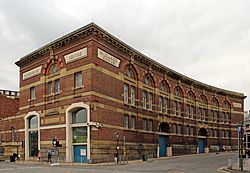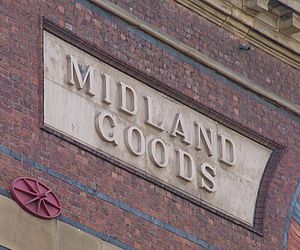National Conservation Centre facts for kids
Quick facts for kids National Conservation Centre |
|
|---|---|

National Conservation Centre, formerly the Midland Railway Goods Warehouse
|
|
| Location | Liverpool, Merseyside, England |
| OS grid reference | SJ 346 905 |
| Built | 1872 |
| Built for | Midland Railway |
| Restored | 1995–96 |
| Restored by | Ken Martin |
| Architect | Henry Sumners |
| Governing body | National Museums Liverpool |
|
Listed Building – Grade II
|
|
| Designated | 14 March 1975 |
| Reference no. | 1062567 |
| Lua error in Module:Location_map at line 420: attempt to index field 'wikibase' (a nil value). | |
The National Conservation Centre in Liverpool, England, is a special place where old and important objects are carefully looked after. It used to be a big warehouse for trains, called the Midland Railway Goods Warehouse.
This building is located in the heart of Liverpool, surrounded by Victoria Street, Crosshall Street, Whitechapel, and Peter Street. After it stopped being a warehouse, it was changed into a conservation centre in the 1990s. This was done for National Museums Liverpool, which looks after many museums and galleries in the city.
For a while, the centre had a special area where visitors could learn about how objects are preserved. This part closed in 2010. However, the important work of conservation still continues inside the building. The National Conservation Centre is also a "Grade II listed building". This means it's a historic building that is protected because of its special importance.
Contents
The Centre's History
From Warehouse to Conservation Hub
The National Conservation Centre building was first built in 1872. It was designed to be a large storage area for goods transported by train. This was for the Midland Railway, a major railway company at the time. A local architect named Henry Sumners designed the original building.
A few years later, in 1878, the building was made even bigger. An extension was added along Peter Street, matching the original style. This allowed for even more goods to be stored.
Becoming a Conservation Centre
Between 1995 and 1996, the building was completely changed. Another local architect, Ken Martin, led the project to turn it into a modern Conservation Centre. This new centre was created for National Museums Liverpool.
At first, the centre had an exhibition area that was open to the public. Here, people could see how experts worked to preserve old items. About 60,000 people visited this area every year! It was a great way to learn about the science behind keeping history alive.
Changes and Continued Work
In September 2005, the centre closed for some updates. It then reopened in June 2006, officially named the National Conservation Centre. Sadly, due to government funding cuts, the visitor area had to close in 2010.
Even though the public exhibition area is no longer open, the vital conservation work continues. Experts still use the building to care for and protect countless historical objects and artworks.
Building's Design
What the Centre Looks Like
The National Conservation Centre is built mostly from red brick. It has a strong stone base, called a rusticated plinth, with stone details and bands. You can also spot some blue brick decorations.
From the outside, the building looks like it has three or four floors. Around the very top, there's a decorative ledge called a cornice, with small supports called modillions. The roof is a hipped roof made of slate.
Special Features
On each of the four sides of the building, there are large arched openings. These were big enough for freight trains to enter and unload goods. The front of the building on Crosshall Street is curved inwards. It has eight sections, or bays. Each section has a tall, blind arch with windows inside. Two of these arches also have arched entrances.
On the Victoria Street side, you can see carved decorations called spandrels. These carvings include shields and the names of different railway stations that the Midland Railway served. In 1921, a professor of architecture from the University of Liverpool, Charles Reilly, thought it was "one of the best buildings in the town". This shows how impressive its design was considered.
The building was officially recognized as a Grade II listed building on March 14, 1975. This protects its unique architectural features for the future.


